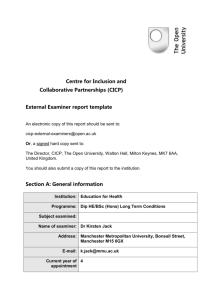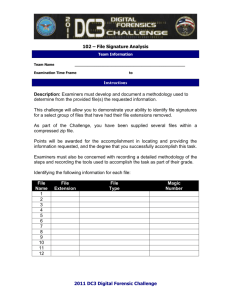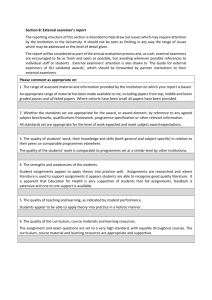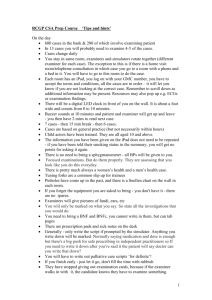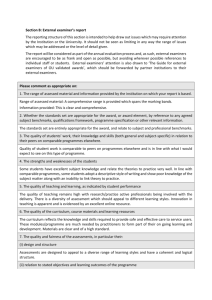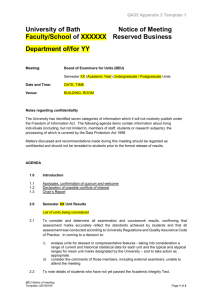1 OHIM's Database for Comparison of Goods and Services 1
advertisement
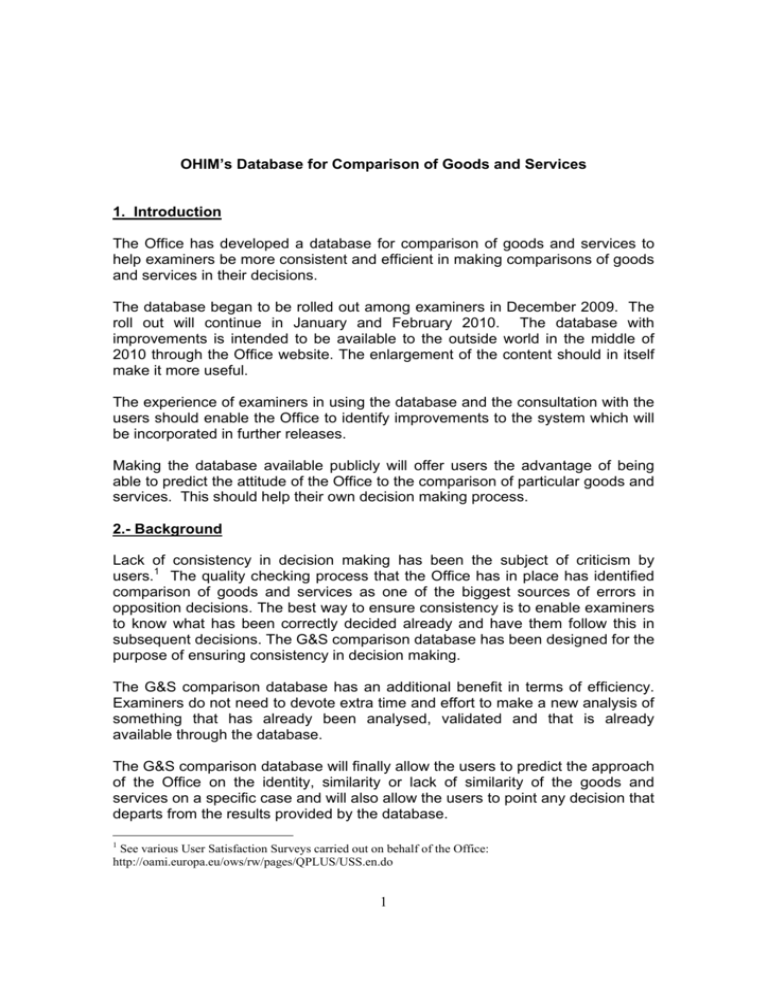
OHIM’s Database for Comparison of Goods and Services 1. Introduction The Office has developed a database for comparison of goods and services to help examiners be more consistent and efficient in making comparisons of goods and services in their decisions. The database began to be rolled out among examiners in December 2009. The roll out will continue in January and February 2010. The database with improvements is intended to be available to the outside world in the middle of 2010 through the Office website. The enlargement of the content should in itself make it more useful. The experience of examiners in using the database and the consultation with the users should enable the Office to identify improvements to the system which will be incorporated in further releases. Making the database available publicly will offer users the advantage of being able to predict the attitude of the Office to the comparison of particular goods and services. This should help their own decision making process. 2.- Background Lack of consistency in decision making has been the subject of criticism by users.1 The quality checking process that the Office has in place has identified comparison of goods and services as one of the biggest sources of errors in opposition decisions. The best way to ensure consistency is to enable examiners to know what has been correctly decided already and have them follow this in subsequent decisions. The G&S comparison database has been designed for the purpose of ensuring consistency in decision making. The G&S comparison database has an additional benefit in terms of efficiency. Examiners do not need to devote extra time and effort to make a new analysis of something that has already been analysed, validated and that is already available through the database. The G&S comparison database will finally allow the users to predict the approach of the Office on the identity, similarity or lack of similarity of the goods and services on a specific case and will also allow the users to point any decision that departs from the results provided by the database. 1 See various User Satisfaction Surveys carried out on behalf of the Office: http://oami.europa.eu/ows/rw/pages/QPLUS/USS.en.do 1 3. Content of the database & presentation of results The database contains a collection of comparisons of goods and services in the form of “pairs” (one good or service compared to another). The database currently2 contains about 10,000 pairs. The pairs are mainly derived from decisions. For the most part these decisions are those handed down by the Court of Justice, General Court, Boards of Appeal and Opposition Divisions. The comparisons are categorised to produce one of five results3: - identical; - highly degree of similarity; - similar; - low degree of similarity and - not similar. Attached to each pair is also an identification of the various factors that have been taken into account in deciding on the relationship between the elements of the pair, which are summarised as follows: producer; public; distribution channels; goods in competition; complementary goods; method of use; purpose; nature of the goods or other4. The decision from which a pair is drawn is also identified in the database. The tool contains information in English only. While Enlgish is the language of the tool, the decisions that are the basis for the establishment of the comparison can be in any of the languages of the Office. See below some screenshots of the tool. 2 January, 2010 3 While these precise expressions are not used in all the decisions analysed, it is possible to categorise what has been decided in different words into one of these categories. Such a categorisation will help examiners in assessing the likelihood of confusion between two trademarks. In making the overall assessment the examiners will take into account all the relevant factors (comparison of signs, degree of distinctiveness of the signs, comparison of the goods and services) as required by the jurisprudence of the Court of Justice. 4 These factors are the ones identified by the Court of Justice as being necessary to take into account when making comparisons between goods and services. 2 3 4. Database maintenance The content of the database is not yet large enough to cover even a majority of comparisons that need to be made. It needs to be enlarged. Even a relatively complete database would have need for refreshment and review. The words that are used to describe goods and services can change over time. New goods and services are entering the market place. Furthermore, case law evolves and occasionally markets themselves change to an extent that existing comparisons are no longer appropriate. For all these reasons the data needs to be updated and maintained. Maintenance and update of the database are performed on a daily basis. The selection of pairs for inclusion in the database requires choices to be made about which decisions to use. There are inconsistincies between decisions and sometimes contradictions. A further factor to be taken into account is the relevance of any decision. Validation of pairs for inclusion in the database is carried out jointly by experts from the Office’s Department for Industrial Property Policy (DIPP) and Trade Mark Department (TMD). Their point of reference is the Manual of Trade Mark Practice.5 There will be additions to fill gaps. There will be corrections where errors are found. Adaptations to reflect the evolution of case law or fundamental changes in markets will be made. Changes will also be made where a new decision provides a better reasoning or presentation of a comparison that already exists. All of the changes will be subject to the same rigorous validation process by the Office (DIPP and TMD). 5 http://oami.europa.eu/ows/rw/pages/CTM/legalReferences/guidelines/OHIMManual.en.do 4 5. Database relevance A difference must be drawn between exact matches and non exact matches. Exact matches contained in the tool constitute an instruction for the examiners that they are required to follow. The guidance that examiners can obtain from results that are are not exact matches but that are close to their precise requirements should guide them in applying Office practice in the decisions they have to take. As regards the Boards of Appeal it has to be noted that Article 136(4) CTMR6 guarantees their independence and ensures that in their decisions they are not bound by any instructions. The database has therefore no binding effect on the Boards of Appeal. 6 Council Regulation No 207/2009 on the Community trade mark 5 6. FAQs When will the database be available to the general public? The G&S comparison database will be avaible as from the middle of 2010. Will the users be involved in the development of the database? Yes. The OHIM will invite some users to perform a usability test in order to identify possible improvements to be implemented in future releases of the tool. What information will the database provide? The comparisons of G&S are categorised to produce one of five results: identical; highly degree of similarity; similar; low degree of similarity and not similar. Attached to each pair is also an identification of the various factors that have been taken into account in deciding on the relationship between the elements of the pair. The decision from which a pair is drawn is also identified in the database. How are the pairs of G&S created? The pairs are derived from decisions. For the most part these decisions are those handed down by the Court of Justice, General Court, Boards of Appeal and Opposition Divisions. The database does not rely on and makes no reference to decisions by either national offices or courts. Some pairs are created by the Office to fill gaps in the database in order to enable pending opposition decisions to be taken. Is there a link to the decision on which the result is obtained? The decision or document that serves as a basis for the given result is listed. The Office will make an effort to provide a link when the first version is made public. How often is the database updated? The database will be updated daily. 6 Will the results of the search be mandatory for the examiners? Exact matches contained in the tool constitute an instruction for the examiners that they are required to follow. Non exact but close matches constitute a guidance for the examiners in applying Office practice in the decisions they have to take. Will the use of the tool deprive the parties of the opportunity to present arguments and evidence? No. The comparion of goods and services is only one element in reaching a decision on likelihoood of confusion. The comparison of signs is another. In making an overall assessment the examiners will, as they do now, take into account all the relevant factors (e.g. degree of distinctiveness of the signs) as required by the jurisprudence of the Court of Justice. It is a fact that in opposition cases while arguments about the comparison of goods and services are frequent evidence is produced more rarely. Is there any algorithm running the comparison of G&S? There is no algorithm. The database is composed of pairs of goods or services whose comparison has been validated by OHIM experts. The tool does not analyse new pairs except to identify whether they are contained in the database or not. Vincent O’Reilly Director Department for Industrial Property Policy 7
